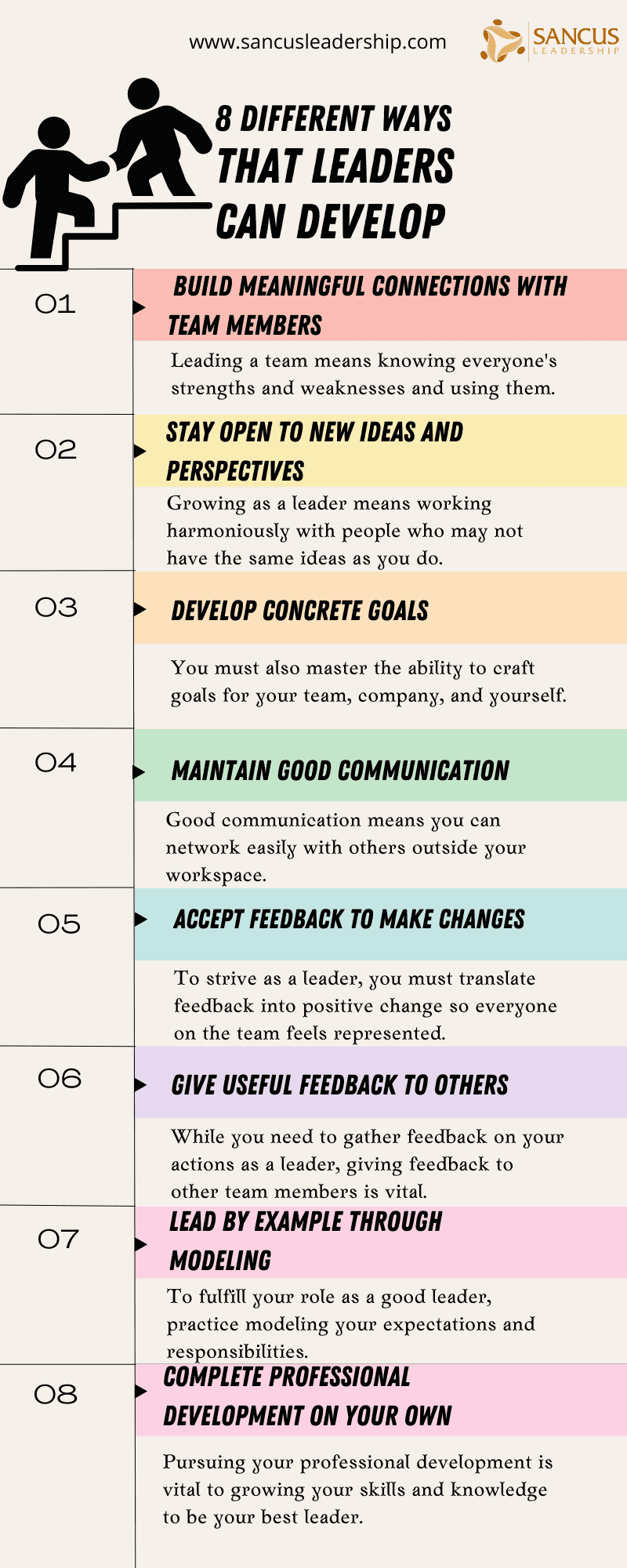CEOs often say, “Our new leaders are the organization’s future,” but they don’t spend any money or time training them. I find this very contradictive, but I don’t want this to be a showstopper for those with great leadership aspirations, so I have put together an article on how you can grow your new leaders (and yourself) without spending any money.
New leaders grow by building meaningful connections with their team, practicing active communication, using feedback to make changes, and engaging in professional development experiences. These actions will help you grow into someone your team can look to for guidance.
There are many paths to becoming the best leader you can be. In this article, I’ll explain all the different practices you can do to shape yourself into a dependable, trustworthy, and goal-oriented leader.
8 Different Ways That Leaders Can Develop

Being a great leader who is excellent at managing teams, projects, and other required tasks takes years of concentrated effort; some are assumed to be natural leaders from birth, but I highly doubt that.
Great leaders honor their commitments and foster collaboration with their team members.
To excel at leading, you must constantly improve upon the knowledge you already know and your skill sets. You can achieve this through personalized experiences like professional development or through actively perfecting your communication, organization, and listening skills with your peers.
To excel at leading, you must constantly improve upon the knowledge you already know and your skill sets.
Luckily, there’s a variety of ways to accomplish this. “All” you need is dedication, effort, and hard work.
1. Build Meaningful Connections With Team Members

Assuming you have a basic level of self-awareness and self-management, the first step to becoming great at managing a team is getting to know the team itself. Communication, performance, and organization will be lacking if you don’t establish connections with your team members.
It’s essential to recognize that everyone has a role to play and can uniquely contribute their input, and leading a team means knowing everyone’s strengths and weaknesses and using them.
… leading a team means knowing everyone’s strengths and weaknesses and using them.
From there, you can use that information to effectively distribute tasks that fit everyone’s qualifications and complete the jobs flawlessly.
Additionally, getting to know your team means you’re putting the effort in to see the value in everyone, which creates a sense of bonding and understanding that you’re all working together for the same goal.
I don’t mean “see the value in everyone” in a hippie way; rather, the exact opposite; I want you to find what precisely they contribute or, with some coaching, will be able to contribute in the future. Stop the cliches and get precise! Your team and your organization need it.
You can learn about and connect with your team through something as simple as starting a real conversation with them where you listen intently. To know them even better, you can also ask questions such as:
- What experience or skills do you have?
- What types of topics or tasks interest you the most?
- What other roles have you held on a team in the past?
- What ideas can you bring to the table for future projects or tasks?
No matter how many people are on your team, it is essential to connect with them. With these formed relationships, there will be more potential to easily collaborate with your team members to solve problems and work through tasks together.
When you know Why your team shows up for work and what internal driving forces they have, leading will be so much easier.
2. Stay Open To New Ideas and Perspectives

You’ll want to keep an open mind when forming these relationships. Growing as a leader means working harmoniously with people who may not have the same ideas as you do.
Assume that there are things you do not already know, that your colleagues know something you don’t, and that those pieces of knowledge are essential for you as a leader. This will allow you to interact with your team in a way that makes them feel listened to and valued.
When you’re on a team, it’s expected that not all members will agree on things every time. Everyone has their own opinion on things and ideas about how specific tasks should be accomplished, and instead of letting that hinder your team and individual growth, use it to fuel them instead.
Multiple people working together means different perspectives, which might bring contrasting ideas. Yet, they can also raise questions and concerns that were not considered initially.
Everyone also displays acts of personal leadership with a different leadership style, whether working independently or with others in a group. Some people may propose more group-oriented and hands-on ideas.
Others suggest working on independent research with an individualistic approach instead.
Being open-minded brings new ideas that have yet to cross your mind straight into the spotlight. You may even wonder why you didn’t come up with such statements.
Taking the time to listen and learn from these new ideas doesn’t make things more challenging. It only strengthens them and makes you a better leader willing to learn from new opportunities.
To grow as a leader, you must be open and accepting of others with contrasting ideas and thoughts. Differences make every team member unique, so ensuring everyone gets a chance to share their input is important.
Do you think most ideas you hear at work are stupid? Well, they are; I agree with you! But the thing is, if you want to find the next Google or Tesla of ideas, you’ll have to endure and encourage the stupid ones.
Do you think most ideas you hear at work are stupid? Well, they are; I agree with you! But …
Most new ideas could be better; that’s part of a creative endeavor. But how will you generate ideas for the next industry-disrupting one if you discourage your team from presenting “wrong” ideas?
A good leader doesn’t dominate everyone else’s ideas with their own. They listen and work to build from them with everyone else.
A good leader doesn’t dominate everyone else’s ideas with their own. They listen and work to build from them with everyone else.
By working together with people with different mindsets and keeping your interest in new ideas, everyone will be able to build off one another. Rather than having it split everyone into separate categories, it will foster a sense of community as everyone works together to find ideas that work for everyone.
3. Develop Concrete Goals

To be an effective and efficient leader, you must also master the ability to craft goals for your team, company, and yourself.
Goals are essential tools that help you understand what you must complete to help your organization, company, and team succeed. With useful goals, you will have direction and results to lead your team.
They need to be specific and have a reachable due date.
By choosing a detailed, clear, and, most importantly, attainable goal, you’re setting yourself on a path to success. This practice is essential for staying on track and promoting organization among your team because you all have the same objective in mind.
If you’re leading a team, it’s vital to work together to discuss what you want to achieve and why you want to reach it in the first place. With this foundation, you and your team will know what to do.
The how of the goal, I firmly believe, should be up to the person closest to the problem. Give the individual the absolute freedom (within clearly specified boundaries) to do whatever they find suitable to solve the issue best.
Whether you’re working independently or managing a small team, a goal must be set to provide something to work towards. It could be as important as tracking a certain amount of sales by the end of the month.
Or, your shared goal could be smaller, like choosing a date for an upcoming meeting.
Learning to make concrete and precise goals promotes organization and motivation for everyone involved. It keeps everyone on the same page and lets you know exactly what to expect of others and yourself.
Goal setting is one of the foundations of self-management, which is the hammer in the leadership toolbox.
Goal setting is one of the foundations of self-management, which is the hammer in the leadership toolbox.
4. Maintain Good Communication

When it comes to being better at leading, practicing good communication is a must. Good communication is not just talking loudly to be understood (which is what we in the Army say the first lieutenants do if a recruit says they do not get it.)
But instead, it’s about straightforwardly conveying essential information in a way that is easy to understand. The importance of language in leadership must be considered.
Good communication means you can network easily with others outside your workspace. While this is true, it’s much more essential to maintain communication with those you work with daily.
Your team members are the ones who are with you through every day and every task.
To convey information, directions, and other responsibilities, you must speak in a way that makes it easy to understand. One great way to improve your communication skills is by improving your public speaking.
Good communication requires active listening, which shows that you truly hear your team members instead of dismissing them. Good leaders should listen, respond, and take action, whether it’s about a question for part of the project or a problem that needs to be worked out.
Active listening is an easy process:
- Listen carefully to your team member by giving them your full attention (assume they know important things that you don’t!)
- Respond to them by repeating parts of what they just said to you (ask, “If I understand you correctly, is this… what you meant?).
- Take action by making changes, answering a question, or coming up with a solution to a proposed problem.
Use Communication to Build Community
In addition, effective communication always promotes open discussion between you and your team. Just like building relationships with your team member, you want to communicate in a way that sets you as someone who is in charge but also approachable.
A sense of community is built upon one’s ability to communicate effectively with everyone on the team, not just certain members. It would help if you generated an open environment where everyone can contribute ideas, voice concerns, or ask questions without worry.
However, if you talk too harshly or unclearly, you may do more harm to your leading position than good. You might come off as intimidating or disproving. Some people may even consider you someone who does not care for the rest of the team. To avoid this misconception, you need to speak in an authoritative and empathetic way.
Some practices of this include:
- Maintaining a positive tone when speaking verbally or in emails, newsletters, and evaluations.
- Letting your team members know that you hear them and understand what they are discussing.
- Answering questions to the best of your ability or referring them to someone who can help instead of ignoring them.
- Refraining from interrupting others as they speak.
- Respond to requests or questions promptly.
| How to speak in an authoritative and empathetic way | Description |
| Maintaining a positive tone | When speaking verbally or in emails, newsletters, and evaluations. |
| Letting your team members know that you hear them | Understand what they are discussing. |
| Refraining from interrupting | Don’t interrupt others from talking. |
| Respond to requests | Always respond or help them in their request. |
5. Accept Feedback To Make Changes

Being a good leader means asking for feedback from people from your shared team or workspace and using that feedback to make important changes for the benefit of everyone involved.
One way is to gather feedback from other team members about your performance through conversation or a formal document like an evaluative survey.
No matter how you seek feedback, it should be obtained in a specific, timely way, cornerstones of input according to my favorite book, Thinking Fast and Slow by Daniel Kahneman (Amazon).
If a team member is concerned that there aren’t enough staff meetings to discuss measures before a deadline, then work to incorporate more communication. If someone points out something that needs to be added to an email, work together to brainstorm how to include it.
As a team leader, you’re the one that they will look to first to see if their requests and needs have been heard. Managing a team doesn’t mean working independently by yourself, nor is it that you’re the only person in charge of how things in the work atmosphere should function.
Leading effectively is based on the opinions of everyone on the team. To strive as a leader, you must translate feedback into positive change so everyone on the team feels represented.
6. Give Useful Feedback To Others

While you need to gather feedback on your actions as a leader, giving feedback to other team members is vital.
Research has revealed that feedback fuels critical aspects of productivity and creativity.
You’ll be ahead of most other business leaders if you offer constructive feedback and compliment your team members.
Because if you highlight the specifics of their accomplishments, you have been paying attention to them. This makes your team feel valued, fueling cohesion, productivity, and efficiency.
As a good leader, your job is to ensure everyone performs to your and the team’s expectations. However, this doesn’t mean you should pick apart everything your team members do negatively. If you only give negative feedback, your relationships with your team members will falter, resulting in less connection among the team.
Instead, use positive feedback and constructive criticism to have a discussion. Yes, you should work together to identify what problems have occurred along the way, but you should highlight all the positive things that have happened.
A newsletter that was sent out got more subscriptions than anticipated, or a critical meeting went very well. If something good happened, take a few moments to address it. This will establish you as a grateful leader and appreciative of the efforts put in by everyone on the team.
Taking the time to send a simple email or have a short discussion to give feedback can go a long way. You’re not just ensuring the team’s tasks go smoothly by providing constructive feedback. You’re also checking up and showing genuine respect towards your team members.
The million-dollar tip is to avoid mixing positive and negative feedback in the same interactions in my twelve years of leadership. The research also supports this; combining the two tends to make people only listen to the negative.
We, as humans, are much more in tune with threats and dangers than praise.
7. Lead By Example Through Modeling

To fulfill your role as a good leader, practice modeling your expectations and responsibilities.
Modeling means demonstrating behavior and showing a visual example of what needs to be done. If you take the time to act in a way you want your team to replicate, you’ll display your expectations.
If you take the time to act in a way you want your team to replicate, you’ll display your expectations.
By modeling these behaviors, you also set the tone for how you want the workplace to function. If you act in a cheerful, sophisticated, and dedicated way, your team will understand that they will need to accomplish that too.
In turn, everyone on the team will be on the same page and know what needs to be done to keep the work environment positive for everyone on the team.
8. Complete Professional Development on Your Own

Pursuing your professional development is vital to growing your skills and knowledge to be your best leader.
Professional development is typically understood as extra education or experience that you do to improve career-based skills. As a leader, professional development helps enrich hard and soft skills.
Hard skills are unique to some professions, while soft skills aren’t centered around a specific career and can be adapted to any discipline.
Some examples of soft skills include:
- Public speaking
- Time management
- Critical thinking
- Research
To be a better leader, select professional development that improves both skills at once. Fortunately, professional development comes in a variety of different activities, including:
- Researching a topic of your choice.
- Earning an online certification.
- Attending a seminar or committee meeting.
- Interviewing others within your desired field.
- Doing community service in a field related to your career.
Professional development is important in your progress towards being a better leader because you learn excellent skills to apply as you work in a team. You can also share these skills with other team members to further a sense of community, generate new ideas, and discuss new project approaches.

New Leaders Grow Through Developing Skills, Communication, and Goals

A good leader takes more than just telling others what to do; to grow into a good leader, you must put in practice and effort.
Learning to be a better leader doesn’t just come from individual work, but rather, it comes from interacting with your team and formulating ideas that include everyone. A leader can only successfully manage a team with communication, acceptance, and connection.
A leader can only successfully manage a team with communication, acceptance, and connection.
You can try out some of these tasks to improve your leadership. However, they will yield different results, so trying different ones is essential to see what works best for you.
Regardless, you must maintain efficient teamwork and collaboration as you develop your skills.
Here’s a video of other essential leadership skills that you can develop to help you be the best leader you can be.
Final Thoughts
Leaders grow by developing their mindsets and skills through various practices. Setting goals, collaborating with others, and considering changes are all essential keys to becoming an efficient leader. With dedication and hard work, you, too, can grow into an excellent leader capable of handling anything.



